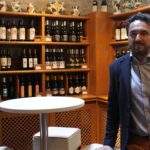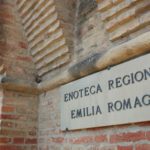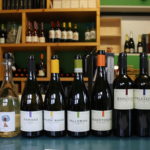Hello Maurizio, can you tell us about the Enoteca Regionale Emilia Romagna and its mission?

The Enoteca Regionale was founded in 1970, taking the place of a promotional exhibition of Dozza’s local products and a country life museum that had been here since the 1960s. It’s an association of producers from the whole of the Emilia Romagna region and was created by the regional administration with the aim of promoting the wines and speciality foods of the region. The stunning location is worthy of our fabulous products and Dozza is an ideal spot as we’re more or less at the theoretical join, linking Emilia and Romagna. We’re described as a permanent exhibition, as people can come just to see the regional wines on the shelves and find out about them, or they can buy the wines as this is a shop too. We organise private tastings and there are always 16 still wines available to try from the wine dispenser. Visitors can also buy a bottle to enjoy here, together with local cheese or charcuterie if they wish. In addition, each Sunday from September to May the wine bar is open for pop-in thematic tastings and we regularly host producers who come to promote their wines. The Enoteca also takes part in numerous wine fairs and events in Italy and around the world to promote Emilia Romagna wines, we hold wine-themed events and tastings, sometimes in other parts of the castle, and we regularly run short courses on wine.
When did you start working here and have you always worked in wine? Have you always lived in the area?

Yes, I’m from Imola, the city best known for its racetrack, about 10km from Dozza and I still live there now. I’ve worked here for 21 years and this was my first full-time job after university. I was studying at Bologna University to become a history teacher and my hobbies and interests included wine – in fact I gained the sommelier diploma at that time – as well as music. I still sing in my spare time and collect vinyl records. I knew the Enoteca and when I heard that the position was open, I jumped at the chance, so my hobby became a profession, while my planned profession in history reverted to a hobby. I’m lucky that history is still a part of my life, working in such an incredible location as this 13th century castle here at Dozza.
The Enoteca is located in the cellars of the castle. Did the castle owners use this space to store their wine?

When the castle was first built in the mid-13th century it was a military fortress but the structure was modified at various times through the ages and was actually a private home until 1960. The cellar where we are was used to preserve food and wine – the ice wells can still be seen. Incidentally, the castle museum is well worth a visit to see the higher floors and towers, which have fantastic views.
What changes in the region’s wine scene have been most notable over the years and do you think that Emilia Romagna wines are becoming better known at last?

Yes! The region’s wines are much better known also at international level largely as quality is so much higher than it was a few decades ago. This is in fact the most significant change – a huge increase in the quality of wines made throughout Emilia Romagna. Producers have worked incredibly well in recent years to improve and continue to do so. Some visitors know this but it’s nice to see the astonishment on the faces of others who are genuinely really impressed by our wines, when they hadn’t necessarily expected to be. They’re also always surprised by the excellent cost-quality ratio of Emilia Romagna wines. The great teamwork between the region’s various sectors is another reason behind the higher profile enjoyed by the wines. For example some consortiums representing our celebrated foods pair their products with Emilia Romagna wines at tastings and events around the world. The Enoteca Regionale is very active in promoting our wines too of course. Here in Emilia Romagna, wineries are typically either large-scale cooperatives or tiny family-run enterprises and we have the challenging job of trying to represent all of them!
Do you agree that wines like Lambrusco have finally shaken off their previous image – also among the international public?
Yes, most definitely. While some international visitors come specifically to seek out the new generation Lambrusco wines they’ve heard about, others are stunned by the wines when they try them as they were perhaps expecting a sweet, less precise version of Lambrusco that they’d found in their own countries in the past.
What trends in the wines of Emilia Romagna are underway?

The new generations of winemakers are expanding experimentation in terms of wine styles and there’s been a rapid growth in investment and interest among both producers and the public for our numerous native varieties, like the fresh white Ortrugo made in the Piacenza hills, semi-aromatic white Famoso and spicy red Centesimino further east, or Malbo Gentile, a red variety grown in both the western and eastern parts of the region for well-structured dry wines and luscious passito sweet wines.
Are most of the region’s wineries well organised for visitors?
A lot of the region’s wineries offer opportunities for tours and tastings with advanced booking and some are very well-structured for visitors, organising all kinds of events. Many of the small-scale wineries however simply don’t have enough time or dedicated staff to welcome many visitors on a regular basis. It is however always worth contacting the wineries to ask for a tasting.
What classic or innovative pairings would you recommend with the region’s typical food and wine?

Classic pairings are numerous throughout the region. The traditional cuisine of the Emilia part of the region, to the west, is fatty, using lard or butter and with many pork-based dishes which pair well with light, slightly sparkling wines. Pignoletto frizzante with mortadella and Lambrusco with salami are classics. Further east, olive oil is traditionally used instead of butter and the ideal wines are generally still with more structure. Good pairings include semi-aromatic white Famoso with asparagus risotto or robust red Bursôn with stews. A more curious pairing that works well is a dry Malvasia di Candia Aromatica from the Parma-Piacenza area with spicy Indian dishes, such as chicken curry, or the spumante version with sushi. Delicious!